

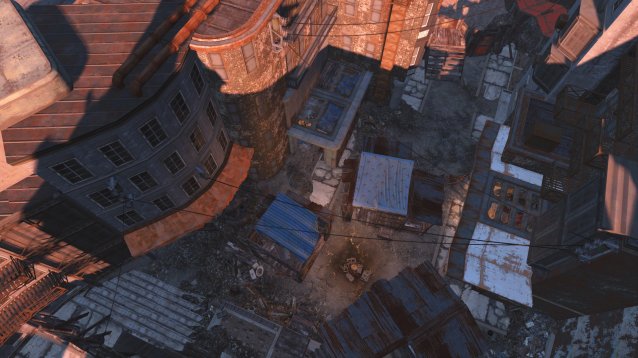
Fallout settlements: the closest we’ll ever get to a Fallout-themed Sims expansion. Designing a settlement can be chaotic, confusing, and inefficient, and nowhere is this more true than in Hangman’s Alley. Recently I was inspired by this article on The Verge, "The Great Fallout 4 Sustainable Housing Experiment", to try a few new tricks in this narrow, street-based camp, and combining it with some techniques I’d already developed on my own, I think I have a settlement now worthy of showing off.
To get some basic instruction on how to build settlements, first check out my guide on the topic. I like to use prefabricated structures to make the design process easier, and the article confirms this is a great way to maximize a small amount of space. However I was intrigued by this new idea of raising the units on platforms. Space for water pumps and crops is limited in Hangman’s Alley, and amenities like craft benches and trade shops seemed impossible. Could raised platforms make it work?
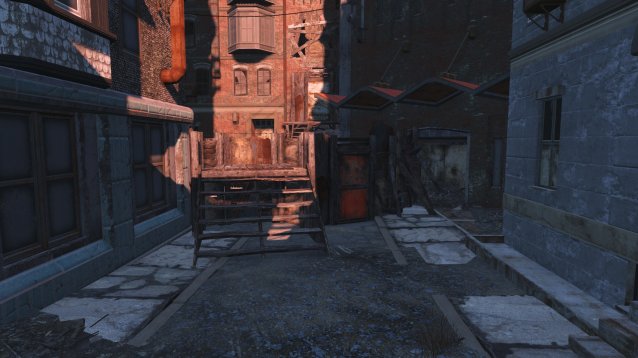
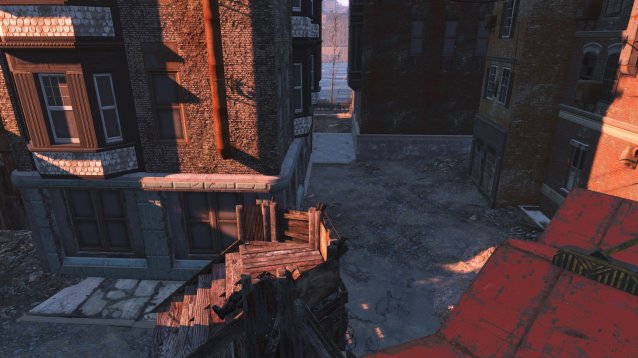
When you first arrive at Hangman’s Alley, you’ll notice there are two walls on either end, and both have doors. On the north end (pictured above) remove the walls, door, and guard post. In that area is an empty strip of open road that we will use for our primary dormitory. Remove all other shanties and shacks in the rest of the settlement (as seen below) too.
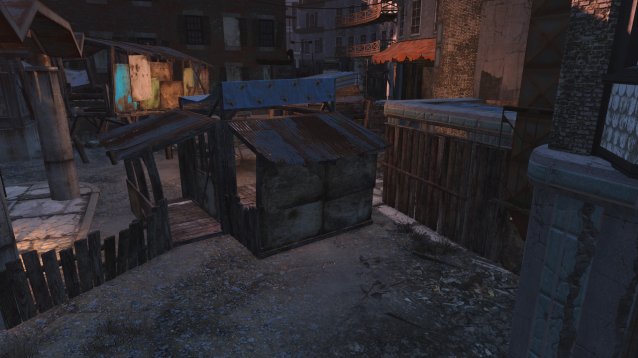
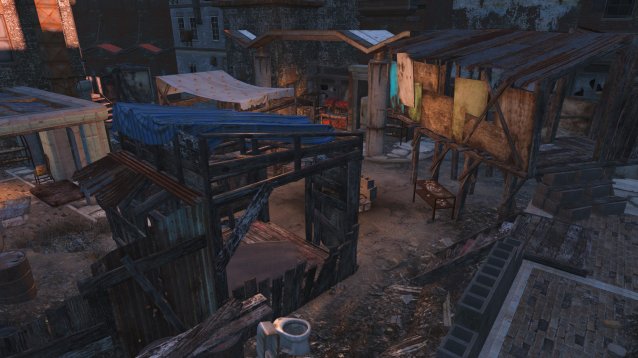
The shack near the west entrance, seen above on the right, cannot be razed. Scrap everything inside.
With this plan you can fit 10-12 people in one longhouse. You will need materials for at least two of the raised platforms (such as you see beneath the shack on the right) and 5 of the pre-built floor and roof units, specifically the second one in the Workshop menu under Structures > Wood > Prefabs, which have a completely flat roof.

Select the raised platforms and place them length-wise along the longest part of the alley. You will be able to fit 3 of the structures on top of the platform. You will also be able to fit two on the side as alcoves in the extra space on the right (if you’re facing north) of the platforms. It will resemble an F in shape, as seen below.
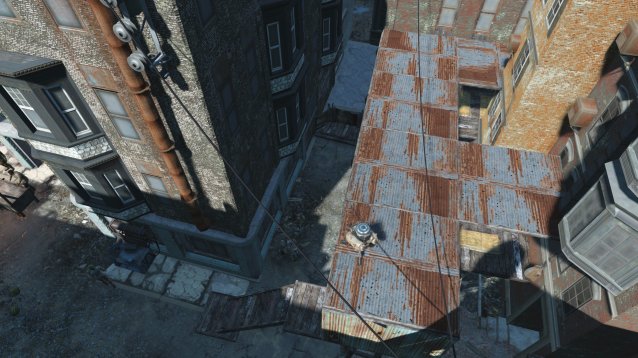
Cover as many as of the open walls as you can. The two side rooms cannot completely facilitate walls, but you can use railings instead, which look pretty cute. Complete the unit with a staircase leading up as pictured above. I chose to make the entrance a sitting room, leaving space for ten beds in the rest of the unit.
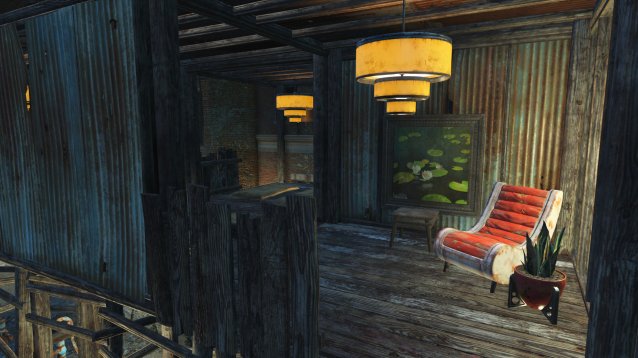


At first, planting crops underneath the platforms sounded like a great idea to save some extra space. But as the author of the Verge article notes, it quickly becomes awkward and annoying, as settlers will take a long time navigating the tricky spacing. A better idea, as I discovered, is to put all the water pumps under there. In this spot they leave more room for planting crops and for settlers to move around while still providing water.
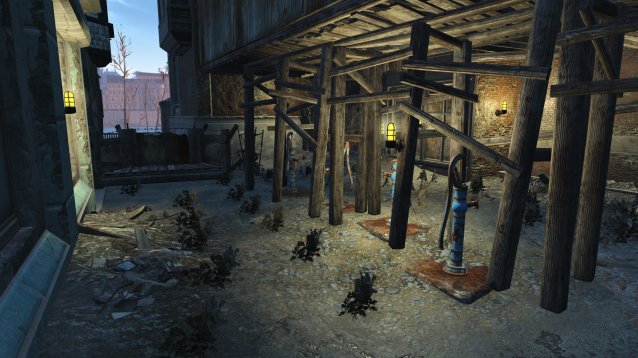
For crops, carrots, tatos, and corn are your best bet for food. They grow in neat rows that can be better for space planning, as opposed to the sprawling melons and gourds. Melons and gourds can be hard to place, and they often float when they are placed on uneven terrain, which looks terrible. I also do not suggest mutfruit. I planted several straight rows of carrots on either side of my dormitory’s raised platforms and on a mound of rubble in a nearby corner. At the end of the alley, I built a guard post and a turret for protection.

On the opposite end on the ground floor, sandwiching the dormitory with the guard post, I built a bathroom.
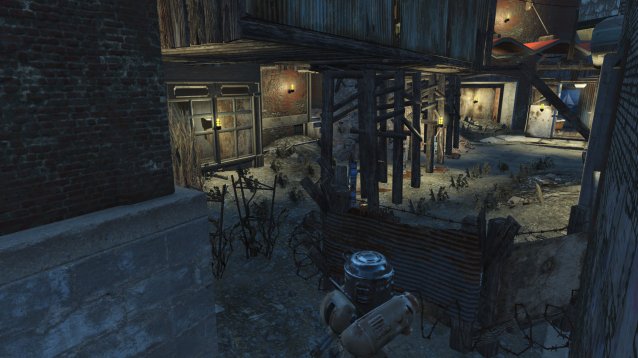
Hangman’s Alley is hardly big enough to fit all your settlers, much less the many trade shops you need. If a herd of Brahmin passes through, things can get very cluttered. Your best option is to find what little “grazing” area you have in the alley, and clear it for the Brahmin.
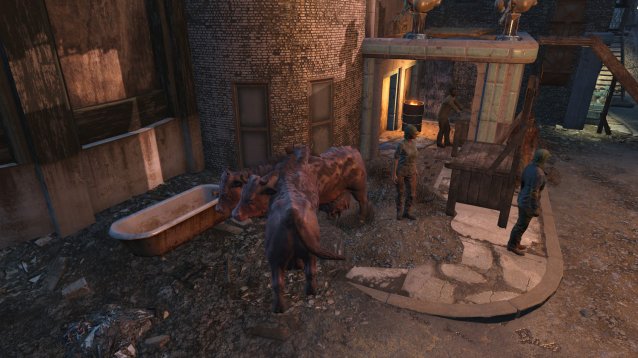
The most ideal area seems to be the mound of rubble right behind the west entrance, where I also placed a guard post and turret facing the door. Put a feeding trough there and the Brahmin will stick to that area instead of tangling themselves in the raised platforms or getting the path of your settlers.

One thing not covered by the Verge article is the fact that you can place generators and pylons on roofs to make a little bit more space on the ground. It's better to put a pylon in the middle of a roof than on the ground, so you have a better chance of lighting the complete building instead of only one side. Turrets and other items can be placed up there, too. On the roof of the small building where the weapons crafting table is initially located in Hangman’s Alley I was able to build four beds, two turrets, and a staircase leading up to them both while still having plenty of room for the shops below. Across the alley, I used generators placed on a roof to funnel Energy down to the recruiting beacon and some pylons below, powering the TV and settlement lighting.

As for the shops, I removed the walls of the building and put two stands in the window-like areas left behind, and another shop at the end near the Brahmin grazing area. I also found room for two other stands near the small shack just inside the west entrance.

Speaking of lighting, it really warms the place up. I put outdoor lights even under the dormitory on the pillars of the raised platforms so the garden area would not be too dark to navigate at night. The high tech lighting in the dorm, which I earned by picking up a copy of Picket Fences, added a nice touch too. I ended up having room for crafting tables along the alley, which I’ve come to think of as a hallway leading to the longhouse dorm.On the right in the picture below you can also see the bathroom I built near the dorm.

Once that was all done I made a bit of a recreation area for my settlers in the middle of town, though admittedly the powered TV does not have any shows to broadcast. It does look nice though. With this set up I was able to fit in plenty of food and water and all 20 beds, though two of them had to be put under the pillars of the west end shack. I'll fix that at a later date.
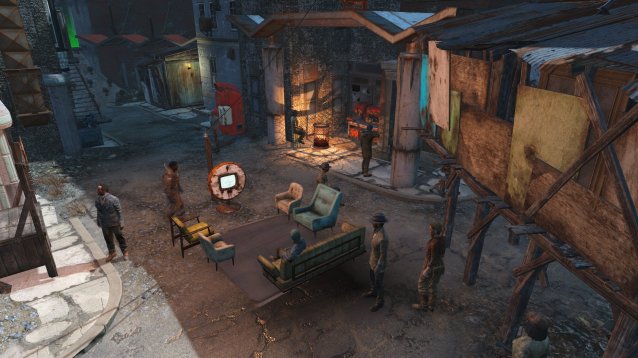
This of course is a work in progress and I intend to refine it further as time goes on. What hot design tips do you have for maximizing settlement space?
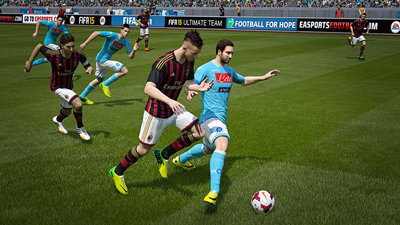



 9 Awesome Board Games Based on Video Games
9 Awesome Board Games Based on Video Games Madonna drops Iconic, Joan of Arc and Hold Tight from Rebel Heart
Madonna drops Iconic, Joan of Arc and Hold Tight from Rebel Heart Nintendo Wii U: The Pros and Cons of Buying It at Launch
Nintendo Wii U: The Pros and Cons of Buying It at Launch RE Revelations 2 Episode 4: Metamorphosis (PC) review
RE Revelations 2 Episode 4: Metamorphosis (PC) review Paleto Score Setup Guide in Grand Theft Auto V
Paleto Score Setup Guide in Grand Theft Auto V